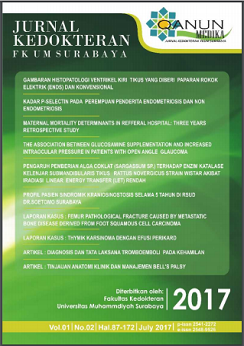Profile of Syndromic Kraniosinostosis for 5 Years in RSUD dr.Soetomo Surabaya
Abstract
Full text article
References
Bannink, N., Nout, E., Wolvius, E.B., Hoeve, H. L. J,Joosten,K. F. M, Mathijssen, M. J. (2010)Obstructive Sleep Apnea In Children With Syndromic Craniosynostosis: Long-Term Respiratory Outcome Of Midface Advancement Int. J. Oral Maxillofac. Surg. Vol.39, pp.115–21 DOI :10.1016/j.ijom.2009.11.021,available
online at http://www.sciencedirect.com
Bartlett, SP., Derderian, C., Craniosynostosis Syndromes,(2014), Congenital Anomalies and Pediatric Plastic Surgery. Grabb and Smith’s Plastic Surgery 7thed. pp: 235-40
Brian U. Ang, Ryan M. Spivak, Hyun-Duck, Richard, E. Kirschner. (2010) Dura in the Pathogenesis of Syndromic Craniosynostosis: Fibroblast Growth Factor Receptor 2 Mutations in Dural Cells Promote Osteogenic Proliferation and Differentiation of Osteoblasts. J Craniofacial Surg.Vol.21(2), ISSN: 1049-2275 DOI:10.1097/SCS.0b013e3181cfe9a0
Chatterjee, JS., Mahmoud, M., Karthikeyan, S., Duncan, C.Dover, MS., Nishikawa, H.(2009) Referral pattern and surgical outcome of sagittal synostosis. J. Plast.Reconstr. Aesthet. Surg. Vol.62, pp.211-5.
Derderian, C., Seaward, J., (2012)Syndromic Craniosynostosis. Seminars in Plastic Surgery. Vol.26(2) pp.64–75.doi: 10.1055/s-0032-1320064
Di Rocco, F., Arnaud, E., Meyer, P., Sainte-Rose, C., Renier,D. (2009) Focus session on the changing “epidemiology†of craniosynostosis (comparing two quinquennia: 1985–1989 and 2003– 2007 and its impact on the daily clinical practice: a review from Necker
Enfants Malades. Childs Nerv. Syst. Vol.25, pp.807–11,Khanna, PC.,(2011) Pictorial Essay: The Many Faces of Craniosynostosis. Indian J Radiol Imaging. Vol.21(1), pp.49–56.doi: 10.4103/0971-3026.76055
Kimonis, V., Gold, JA., Hoffman, TL., Panchal, J., Boyadjiev,SA. (2007) Genetics of craniosynostosis. SeminPediatrNeurol. Vol.14, pp.150–61
Kniffin, CL.,(2013) Apert Syndrome :Acrocephalosyndactyly,Type I; Acs I;Apert- Crouzon Disease, Included Acrocephalosyndactyly, Type Ii, included Acs Ii, Included Vogt Cephalodactyly. Online Mendelian Inheritance In Man.
Ko, JM., (2016) Genetic Syndromes Associated with Craniosynostosis. J of Korean Neurosurg Soc. Vol.59(3), pp.187–191.Doi: 10.3340/jkns.2016.59.3.187
Kreiborg, S., Cohen, MM Jr., (1992) Birth Prevalence Studies of the Crouzon syndromes Comparison of Direct and Indirect Methods.Clin. Genet., vol.41, pp.12-15.
Marsh, JL., Gurley, JM., Kane, AA. (2005)Nonsyndromic Craniosynostosis In : Mathes SJ, Hentz VR. Plastic Surgery, 2nd ed, WB Saunders, Philadelphia . pp.135-161
Pagnoni, M., et al. (2014) Surgical timing of craniosynostosis: What to do and when,J Cranio-Maxillo-Facial Surg.Vol.42, pp. 513- 9.
Panigrahi, I., (2011) Review Article.Craniosynostosis genetics:The mystery unfolds. Indian J of Human Gen., Vol.17(2). DOI: 10.4103/0971-6866.86171
Pournima, G., Monica, Y., Meghna, S. (2011) Crouzon Syndrome:A Case Report,Eur J of Dentistry and Med,pp.1-6,. DOI :
3923/ejdm.2011
O'Rahilly, R., Müller, F., (2001) Human embryology & teratology. Wiley-Liss, New York, ISBN 0-471-38225-6
Shin, JH.,Persing, JA. (2007)Nonsyndromic Craniosynostosis And Deformational Plagiocephaly.Congenital Anomalies and Pediatric Plastic Surgery,Grabb and Smith’s Plastic Surgery, 6th Edition. Boston: Little Brown,Virchow R. Berh Phyd Med Gesellsch
Wuerzburg. 1851;2:231–71
WHO. Congenital Anomaly
http://www.who.int/mediacentre/factsheets/f
s370/en/Wilkie, AO., (2005) Bad bones, absent smell, selfish
testes: the pleiotropic consequences of human FGF receptor mutations. Cytokine Growth Factor Rev. vol.16, pp.187–203.
Authors

Qanun Medika by FK UM Surabaya is liscence under Lisensi Creative Commons Atribusi 4.0 Internasional.

